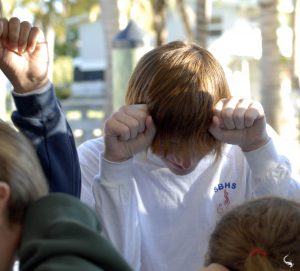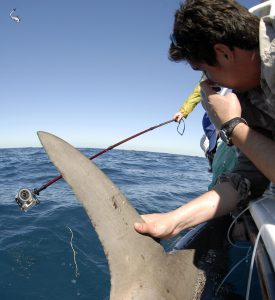Nurses and Tigers and Hammers, Oh My!
Saturday, January 29th 2011
Like most days we stepped into the chill of an early South Florida morning. Little did we know our trip with South Broward High School was going to be very eventful… The day started out like any other RJD trip. Everybody went to work extending lines, baiting hooks, and going about the routine. But, the day was soon to be far from usual.

As one of our many superstitions, we ask students on the boat to invoke hammerheads by putting their fists on either side of their faces simulating the shark’s peculiar head shape. It works! I promise! Click to enlarge.
The RJD program welcomed Jillian Morris, Executive Director and Camerawoman for OceanicAllstars. OceanicAllstars produces conservation themed media in an effort to educate the public about the plight of sharks and our oceans. Jillian spent the day photographing the sharks and interns at work, capturing countless exciting moments from the trip.

Captain Curt finishes placing a new satellite tag on the beautiful fin of a Great Hammerhead. Click to enlarge.
The first shark was a Great Hammerhead, a true indication of the future success of the day. The shark was fit for satellite tagging and the procedure was carried out efficiently and safely from the stern of the boat. Three other Great Hammerheads were caught throughout the day. They all swam away with satellite tags, opening our eyes to their habits and paths through the ocean and giving us greater insight into their lives. Such data will help us to better understand how to manifest the conservation effort sharks need so desperately.
Five large nurse sharks were also caught during the trip. Although they are not the most desired of species by the interns and students because they are so difficult to work with, the data we collect from them provides a strong alternate end of the shark spectrum in contrast to species like the Great Hammerhead, which are far less resilient than nurses. There is much to appreciate about nurse sharks, even if they do not evoke the excitement felt when a silver shadow of a hammer rises from the depths.
Earlier in the morning I had expressed my desire to see a Tiger shark. It seemed as if I was the last of the interns to have never seen the characteristic spotted or striped pattern. After tagging the Hammerheads the day would have been exceptional without the surprise to follow. And then there she was. She was not yet fully striped, still showing the spotted pattern of her youth. The Tiger shark was brought on deck, using Captain Curt’s helpful sling, and quickly satellite tagged. She swam away safely, dipping below the slippery surface and out of sight.
The sharks became less frequent towards the end of the day, but we were once again elated when a Scalloped Hammerhead was cruising at the other end of one of the lines. Like its close relative the Great Hammerhead, the Scalloped Hammerhead is a delicate species, requiring an immediate and quick work up. The crew collected necessary data and quickly released the shark.
This trip was definitely memorable. All of the satellite tags on board were deployed, making for a historical day. We are looking forward to the future transmissions of the sharks tagged today. They will greatly contribute to our understanding of the shark species in South Florida. With further research and the curiosity of young people, we will learn how to best protect the sharks that never cease to inspire our imaginations.
Cameron Rhodes, RJD intern




This was my second shark trip with my school of the University of Miami, and so far it was definitely the best! The amount of different types of marine life i saw was incredible. Beautiful weather and the best of people!
I mean with my school South Broward and the school of the University of Miami*
Shark fins are mostly cartilage, so this does not hurt the shark. Much like an earing.
Also, based on the evidence we have, it appears sharks do not feel pain
For more details See:
http://elasmo-research.org/education/topics/s_pain.htm
This, also, was my second shark trip and I was put in awe. It was completely amazing to see all of the marine life that lives right under our very nose. From Great Hammerheads and Scalloped Hammerheads, to Nurses and a Tiger, this day was truly memorable. I learned so much from just being out there in the field and being a helping hand. I’ll definitely spring at the chance to go on the next one!
Plus sharks are tough, with getting an “ear pierced” not going to be a big deal, and ultimately it is going to help ALL sharks in the future.